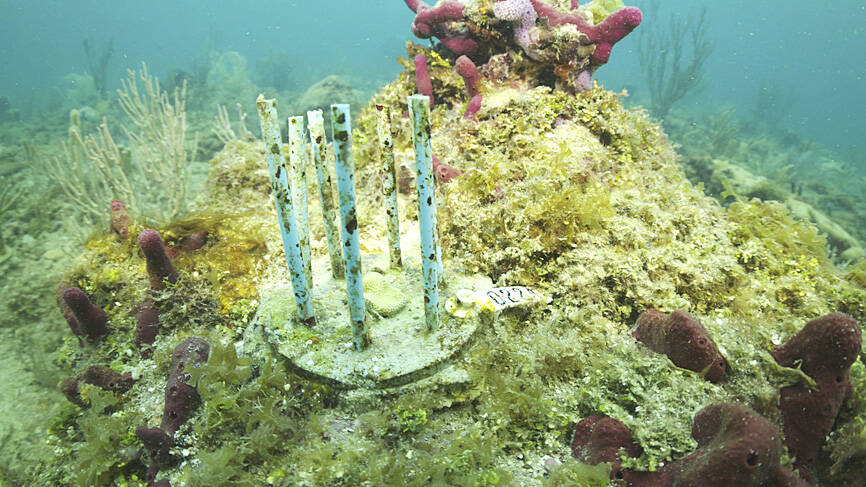South Florida researchers trying to prevent predatory fish from devouring laboratory-grown coral are grasping at biodegradable straws in an effort to restore what some call the rainforest of the sea.
Scientists around the world have been working for years to address the decline of coral reef populations. Just last summer, reef rescue groups in South Florida and the Florida Keys were trying to save coral from rising ocean temperatures. Besides working to keep existing coral alive, researchers have also been growing new coral in labs and then placing them in the ocean.
However, protecting the underwater ecosystem that maintains upwards of 25 percent of all marine species is not easy. Even more challenging is making sure that coral grown in a laboratory and placed into the ocean does not become expensive fish food.

Photo: AP
Marine researcher Kyle Pisano said one problem is that predators like parrot fish attempt to bite and destroy the newly transplanted coral in areas like South Florida, leaving them with less than a 40 percent survival rate. With projects calling for thousands of coral to be planted over the next year and tens of thousands of coral to be planted over the next decade, the losses add up when coral pieces can cost more than US$100 each.
Pisano and his partner, Kirk Dotson, have developed the Coral Fort, claiming the small biodegradable cage that is made in part with drinking straws boosts the survival rate of transplanted coral to more than 90 percent.
“Parrot fish on the reef really, really enjoy biting a newly transplanted coral,” Pisano said. “They treat it kind of like popcorn.”
Fortunately, the fish eventually lose interest in the coral as it matures, but scientists need to protect the coral in the meantime. Stainless steel and PVC pipe barriers have been set up around transplanted coral in the past, but those barriers needed to be cleaned of algae growth and eventually removed.
Pisano had the idea of creating a protective barrier that would eventually dissolve, eliminating the need to maintain or remove it. He began conducting offshore experiments with biodegradable coral cages as part of a master’s degree program at Nova Southeastern University. He used a substance called, polyhydroxyalkanoate (PHA), a biopolymer derived from the fermentation of canola oil. PHA biodegrades in the ocean, leaving only water and carbon dioxide. His findings were published last year.
The coral cage consists of a limestone disc surrounded by eight vertical phade brand drinking straws, made by Atlanta-based WinCup Inc. The device does not have a top, because the juvenile coral needs sunlight and the parrot fish do not generally want to position themselves facing downward to eat, Pisano said.
Dotson, a retired aerospace engineer, met Pisano through his professor at Nova Southeastern, and the two formed Reef Fortify Inc to further develop and market the patent-pending Coral Fort. The first batch of cages were priced at US$12 each, but Pisano and Dotson believe that could change as production scales up.
Early prototypes of the cage made from phade’s standard drinking straws were able to protect the coral for about two months before dissolving in the ocean, but that was mot quite long enough to outlast the interest of parrot fish. When Pisano and Dotson reached out to phade for help, the company assured them that it could make virtually any custom shape from its biodegradable PHA material.
“But it’s turning out that the boba straws, straight out of the box, work just fine,” Dotson said.
Boba straws are wider and thicker than normal drinking straws. For Pisano and Dotson, that extra thickness means the straws last just long enough to protect the growing coral before harmlessly disappearing.
Reef Fortify is hoping to work with reef restoration projects all over the world. The Coral Forts are already being used by researchers at Nova Southeastern and the University of Miami, as well as Hawaii’s Division of Aquatic Resources.
Rich Karp, a coral researcher at the University of Miami, said they have been using the Coral Forts for about a month. He said that doing any work underwater takes a great deal of time and effort, so having a protective cage that dissolves when it is no longer needed basically cuts their work in half.
“Simply caging corals and then removing the cages later, that’s two times the amount of work, two times the amount of bottom time,” Karp said. “And it’s not really scalable.”
Experts say coral reefs are a significant part of the oceanic ecosystem. They occupy less than 1 percent of the ocean worldwide, but provide food and shelter to nearly 25 percent of sea life. Coral reefs also help to protect humans and their homes along the coastline from storm surges during hurricanes.

‘THEY KILLED HOPE’: Four presidential candidates were killed in the 1980s and 1990s, and Miguel Uribe’s mother died during a police raid to free her from Pablo Escobar Colombian presidential candidate Miguel Uribe has died two months after being shot at a campaign rally, his family said on Monday, as the attack rekindled fears of a return to the nation’s violent past. The 39-year-old conservative senator, a grandson of former Colombian president Julio Cesar Turbay (1978-1982), was shot in the head and leg on June 7 at a rally in the capital, Bogota, by a suspected 15-year-old hitman. Despite signs of progress in the past few weeks, his doctors on Saturday announced he had a new brain hemorrhage. “To break up a family is the most horrific act of violence that

HISTORIC: After the arrest of Kim Keon-hee on financial and political funding charges, the country has for the first time a former president and former first lady behind bars South Korean prosecutors yesterday raided the headquarters of the former party of jailed former South Korean president Yoon Suk-yeol to gather evidence in an election meddling case against his wife, a day after she was arrested on corruption and other charges. Former first lady Kim Keon-hee was arrested late on Tuesday on a range of charges including stock manipulation and corruption, prosecutors said. Her arrest came hours after the Seoul Central District Court reviewed prosecutors’ request for an arrest warrant against the 52-year-old. The court granted the warrant, citing the risk of tampering with evidence, after prosecutors submitted an 848-page opinion laying out

STAGNATION: Once a bastion of leftist politics, the Aymara stronghold of El Alto is showing signs of shifting right ahead of the presidential election A giant cruise ship dominates the skyline in the city of El Alto in landlocked Bolivia, a symbol of the transformation of an indigenous bastion keenly fought over in tomorrow’s presidential election. The “Titanic,” as the tallest building in the city is known, serves as the latest in a collection of uber-flamboyant neo-Andean “cholets” — a mix of chalet and “chola” or Indigenous woman — built by Bolivia’s Aymara bourgeoisie over the past two decades. Victor Choque Flores, a self-made 46-year-old businessman, forked out millions of US dollars for his “ship in a sea of bricks,” as he calls his futuristic 12-story

FORUM: The Solomon Islands’ move to bar Taiwan, the US and others from the Pacific Islands Forum has sparked criticism that Beijing’s influence was behind the decision Tuvaluan Prime Minister Feletei Teo said his country might pull out of the region’s top political meeting next month, after host nation Solomon Islands moved to block all external partners — including China, the US and Taiwan — from attending. The Pacific Islands Forum (PIF) leaders’ meeting is to be held in Honiara in September. On Thursday last week, Solomon Islands Prime Minister Jeremiah Manele told parliament that no dialogue partners would be invited to the annual gathering. Countries outside the Pacific, known as “dialogue partners,” have attended the forum since 1989, to work with Pacific leaders and contribute to discussions around